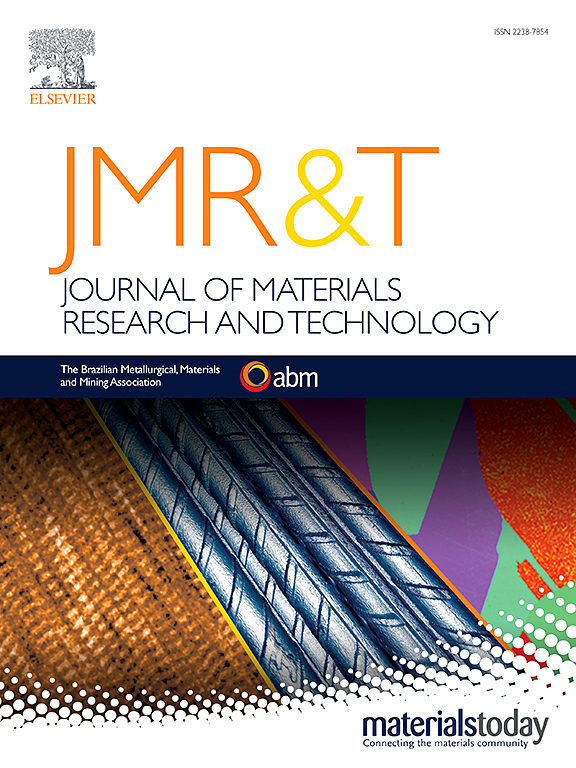高强度、高抗疲劳性能的最小表面钽支架的研制与表征
IF 6.2
2区 材料科学
Q1 MATERIALS SCIENCE, MULTIDISCIPLINARY
Journal of Materials Research and Technology-Jmr&t
Pub Date : 2025-03-22
DOI:10.1016/j.jmrt.2025.03.108
引用次数: 0
摘要
增材制造的钽支架由于其特殊的骨整合和骨生长能力,在承重骨重建方面表现出很大的希望。然而,提高它们的机械性能,特别是抗疲劳性能,仍然是一个关键目标。本研究强调了增材制造的三周期最小表面(TPMS)多孔钽支架的显著力学性能。在孔隙率为70%的情况下,TPMS钽支架的抗压屈服强度达到57.6 MPa,比孔隙率相同的小梁多孔结构高出70%以上,比RDOD结构高出30%以上。其弹性模量达到7.3 GPa,比RDOD和钽小梁支架提高95%。值得注意的是,这种支架显示出令人印象深刻的延展性,即使在50%的最大应变下也没有宏观脆性断裂。在静压缩过程中,钽支架结构呈现出一层一层的变形破坏机制,导致位错密度大幅上升,晶界内出现低角度晶界。这表明钽材料的破坏机制主要是塑性变形和韧性断裂。TPMS钽支架表现出优异的抗疲劳性能,没有发生机械断裂失效,试验后仍保持其残余抗压屈服强度,而RDOD钽支架的疲劳失效强度为26 MPa。与RDOD设计相比,TPMS多孔结构具有更好的应力分布和更小的应力集中,从而提高了力学性能。鉴于其特殊的机械性能,TPMS钽支架作为承重骨植入物在临床应用中具有重要的潜力。本文章由计算机程序翻译,如有差异,请以英文原文为准。
Development and characterization of minimal surface tantalum scaffold with high strength and superior fatigue resistance
Additively manufactured tantalum scaffolds show great promise for load-bearing bone reconstruction due to their exceptional osseointegration and bone in-growth capabilities. Nonetheless, enhancing their mechanical properties, particularly fatigue resistance, remains a critical goal. This study highlights the remarkable mechanical properties of additively manufactured triple periodic minimal surface (TPMS) porous tantalum scaffolds. With a porosity of 70 %, the TPMS tantalum scaffold exhibits a compressive yield strength of 57.6 MPa, surpassing trabecular porous structures with identical porosity by over 70 % and the rhombic dodecahedron (RDOD) structure by over 30 %. Furthermore, its elastic modulus reaches 7.3 GPa, marking a 95 % increase compared to RDOD and trabecular tantalum scaffolds. Notably, this scaffold demonstrates impressive ductility, with no macroscopic brittle fractures even at a maximum strain of 50 %. During static compression, the tantalum scaffold structure showcases a layer-by-layer deformation failure mechanism, leading to a substantial rise in dislocation density and low-angle grain boundaries within the grain regions. This suggests that the failure mechanism primarily arises from plastic deformation and ductile fracture in tantalum materials. The TPMS tantalum scaffold displays excellent fatigue resistance without mechanical fracture failure, maintaining its residual compression yield strength post-testing, unlike the RDOD tantalum scaffold which experiences fatigue failure with a strength of 26 MPa. The TPMS porous structure exhibits superior stress distribution and reduced stress concentration compared to the RDOD design, resulting in enhanced mechanical performances. Given its exceptional mechanical properties, the TPMS tantalum scaffold holds significant potential for clinical applications as load-bearing bone implants.
求助全文
通过发布文献求助,成功后即可免费获取论文全文。
去求助
来源期刊

Journal of Materials Research and Technology-Jmr&t
Materials Science-Metals and Alloys
CiteScore
8.80
自引率
9.40%
发文量
1877
审稿时长
35 days
期刊介绍:
The Journal of Materials Research and Technology is a publication of ABM - Brazilian Metallurgical, Materials and Mining Association - and publishes four issues per year also with a free version online (www.jmrt.com.br). The journal provides an international medium for the publication of theoretical and experimental studies related to Metallurgy, Materials and Minerals research and technology. Appropriate submissions to the Journal of Materials Research and Technology should include scientific and/or engineering factors which affect processes and products in the Metallurgy, Materials and Mining areas.
 求助内容:
求助内容: 应助结果提醒方式:
应助结果提醒方式:


